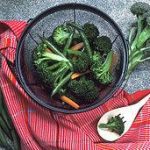 Summer is around the corner. Fresh fruits and vegetables are abundant in farmers markets and stores. However, after hearing news about illnesses such as Salmonella and E. coli from produce, one may be hesitant about taking advantage of seasonal produce and miss out on the important nutrients they provide.
Summer is around the corner. Fresh fruits and vegetables are abundant in farmers markets and stores. However, after hearing news about illnesses such as Salmonella and E. coli from produce, one may be hesitant about taking advantage of seasonal produce and miss out on the important nutrients they provide.
Washing produce is the best way to avoid foodborne illness. The FDA recommends washing produce before peeling, cutting, and processing. Wash hands in warm soapy water before preparing food. Wash utensils and food preparation surfaces with hot soapy water. Select produce that has intact skin without bruises.
HOW TO WASH VEGETABLES
Use cool, clean water that is suitable for drinking. Scrub thick-skinned vegetables, such as potatoes and carrots, to remove dirt. Soak vegetables with a large surface area, such as broccoli, in cold water for 2-3 minutes. Rinse fragile fruits such as strawberries and blueberries in a colander.
Washing produce with detergents can leave unsafe residues. A recent study found that commercial produce washes were no more effective than clean drinking water for removing bacteria and pesticide residue. Store washed fruits and vegetables in the refrigerator.
DON’T WASH THESE
It is not advised to re-wash produce that is labeled, “pre-washed,” “triple washed,” or “ready to use.” Re-washing these products may add contaminants.
FIND OUT MORE
Fresh fruits and vegetables have many nutrients that are key to balancing the metabolism and losing weight. I offer a system of using whole foods to achieve better health and weight called metabolic balance®. Contact me for a 30-minute wellness assessment to learn how you can achieve your health and weight-loss goal, naturally.
Source: University of Maine, Image: National Cancer Institute
RELATED POSTS
Metabolic Balance Makes Food Shopping Simple
Picking the Best Produce
Free Recipe: Glamorous Marinated Goat Cheese

Myra Nissen, CCH
Copyright © 2014 –, Myra Nissen.
Would you like to include this article in your newsletter or website?
You can as long as you include the following blurb with it:
This article was brought to you by Myra Nissen, CCH, RSHom(NA), Board Certified Classical Homeopath. Myra teaches women how to recognize their body’s unique needs and cues and uses Homeopathy to help empower women to take control of their bodies, health, and well-being. Find out more, visit her blog www.myranissen.com/blog.
